Original article by Moulik Nagesh
Original source: Binance Research
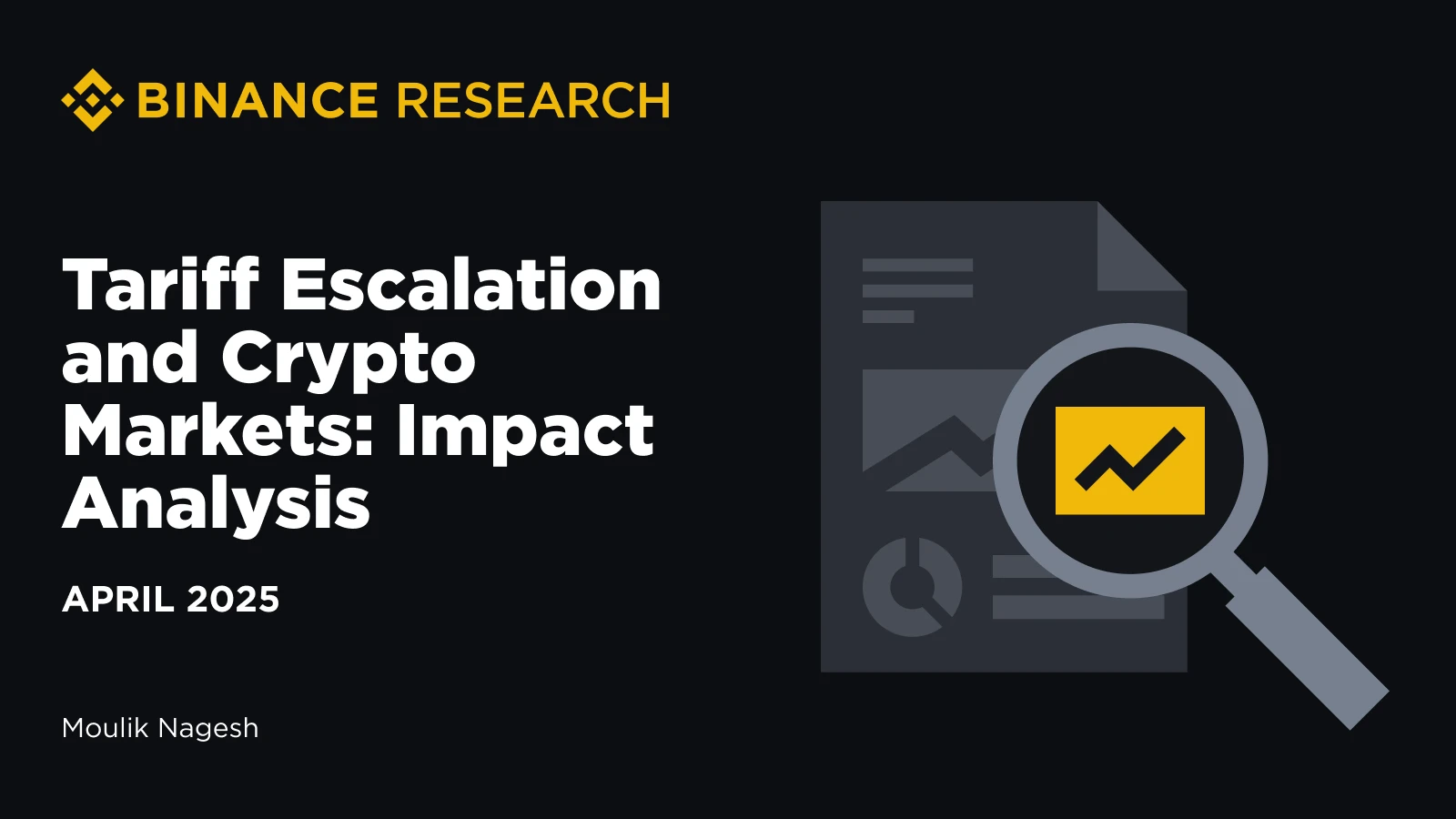
Key Takeaways
In 2025, US-led protectionism is back with a vengeance. Since Donald Trump was re-elected as president in January 2025, the US has raised fears of a global trade war by imposing a series of massive new tariffs, both on specific countries and covering specific industries. In the past week alone, the US has introduced a new round of “reciprocal” tariffs, and other countries have announced countermeasures.
This report will analyze how these tariffs (the most aggressive since the 1930s) affect the macroeconomy and crypto markets. We will examine the tariff levels, macroeconomic trends (including inflation, growth, interest rates, and the Fed outlook) and their impact on crypto asset performance, volatility, and correlation based on data. Finally, we will also explore key observations in the future and the market outlook that crypto assets may face in an environment of stagflation and protectionism.
Tariffs return in 2025
After several years of relative trade peace, there was a rapid reversal in 2025. Within his first days back in the White House, President Trump began fulfilling his campaign promise to impose tariffs on a wide range of imports—covering specific countries and industries—under emergency authorities.
Trade tensions escalated further on April 2, when the United States announced comprehensive reciprocal tariffs and named the day Liberation Day, marking the latest turning point in this round of global trade wars. Many countries previously viewed their trade relations with the United States as normal, but now have fundamentally changed. Major events over the past week include:
Base Tariff: The United States announced a new 10% flat tariff on all imports, reversing decades of trade liberalization. The base tariff took effect on April 5.
Targeted tariffs: Higher country-specific tariffs are added to the base rate. President Trump calls these reciprocal tariffs, aimed at countries that have set up high barriers to American products. It is worth noting that Chinese goods will be subject to an additional 34% tariff - after adding the original 20%, the combined tariff rate reaches 54%. Targeted tariffs for other countries include: 20% for EU goods, 24% for Japan, 46% for Vietnam, and 25% for automobile imports. Canada and Mexico were not included in the new list because they were already subject to a 20% tariff in February.
Global pushback: The United States’ trading partners responded quickly. As of mid-February, several countries that were hit with tariffs early on had announced countermeasures. Canada, which failed to win an extension of U.S. tariffs, decided to impose a 25% tariff on all U.S. imports. China also responded early, and on April 4, it escalated further, announcing a 34% tariff on all U.S. imports.
As “reciprocal” tariffs come into effect and trade tensions intensify, more countries are expected to introduce their own countermeasures. The European Union has made it clear that it will respond soon, and several other major economies have also developed relevant countermeasures. Although the full extent of the global response is still unclear, all signs currently indicate that a broad trade war involving multiple fronts is taking shape.
Figure 1: The “Liberation Day” tariffs on April 2, 2025, cover up to 60 countries, including several major U.S. trading partners
Note: This table reflects the “reciprocal” tariffs imposed by the United States on its top ten import sources on April 2.

Source: BBC, X (@WhiteHouse), Binance Research, as of April 3, 2025
These policies have sent U.S. import taxes soaring to their highest levels since the 1930 Smoot-Hawley Tariff Act, which imposed sweeping tariffs on thousands of goods during the Great Depression. The average U.S. tariff has risen to about 18.8%, according to available data, with some estimates as high as 22%—a dramatic jump from 2.5% in 2024.
For reference, the average U.S. tariff rate has typically remained between 1 and 2% over the past few decades; even during the 2018-2019 U.S.-China trade war, it only rose to around 3%. The 2025 measures therefore constitute a tariff shock unprecedented in modern history—almost tantamount to a return to 1930s protectionism.
Figure 2: US tariff hikes push import tax rates to highest level in nearly 100 years
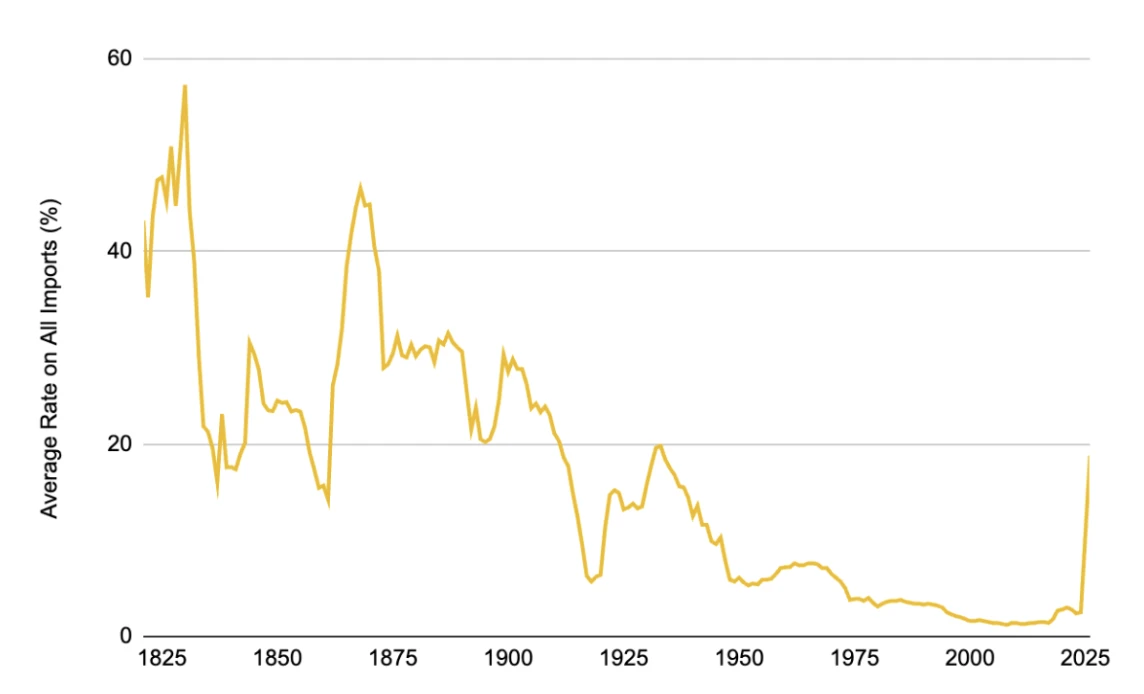
Source: Tax Foundation, Binance Research, as of April 3, 2025
Market impact: Cooling demand, risk aversion and soaring volatility
1. Cooling demand and rising risk aversion
Market sentiment has clearly turned cautious, with investors reacting to the tariff announcement in typical “risk-off” fashion. The total crypto market value has fallen by about 25.9% from its January high, with a market value loss of nearly $1 trillion, highlighting its high sensitivity to macroeconomic instability.
Crypto assets and the stock market have moved in lockstep, with both facing cooling demand, widespread selling and entering correction territory. In contrast, traditional safe-haven assets such as bonds and gold have performed well, with gold hitting record highs in a row, becoming a safe haven for investors amid rising macro uncertainty.
Chart 3: Since the initial tariff announcement, crypto markets are down 25.9%, the SP 500 is down 17.1%, while gold is up 10.3% and hitting consecutive all-time highs

Source: Investing.com, CoinGecko, Binance Research, as of April 4, 2025
The dramatic market reaction also highlights the performance characteristics of crypto assets during periods of intense risk aversion: Bitcoin (BTC) fell 19.1%, and most major altcoins fell by as much or more. Ethereum (ETH) fell more than 40%, and high-beta sectors (such as meme coins and artificial intelligence-related tokens) plummeted by more than 50%. This round of selling wiped out most of the gains in the crypto market since the beginning of the year. As of early April, even BTCs year-to-date (YTD) returns have turned negative - despite its strong performance in 2024.
Figure 4: Under the macro panic caused by tariffs, altcoins fell significantly more than Bitcoin, exacerbating market pessimism

Source: CoinGecko, Binance Research, as of April 4, 2025
As the crypto market increasingly exhibits risky asset characteristics, if the trade war continues, it may continue to suppress capital inflows and suppress demand for digital assets in the short term. Funds may continue to wait and see, or switch to assets such as gold that are considered safer. This sentiment is also reflected in a recent fund manager survey, where only 3% of respondents said they would allocate Bitcoin in the current environment, while 58% preferred gold.
Chart 5: Only 3% of global fund managers consider Bitcoin as a preferred asset class in a trade war scenario
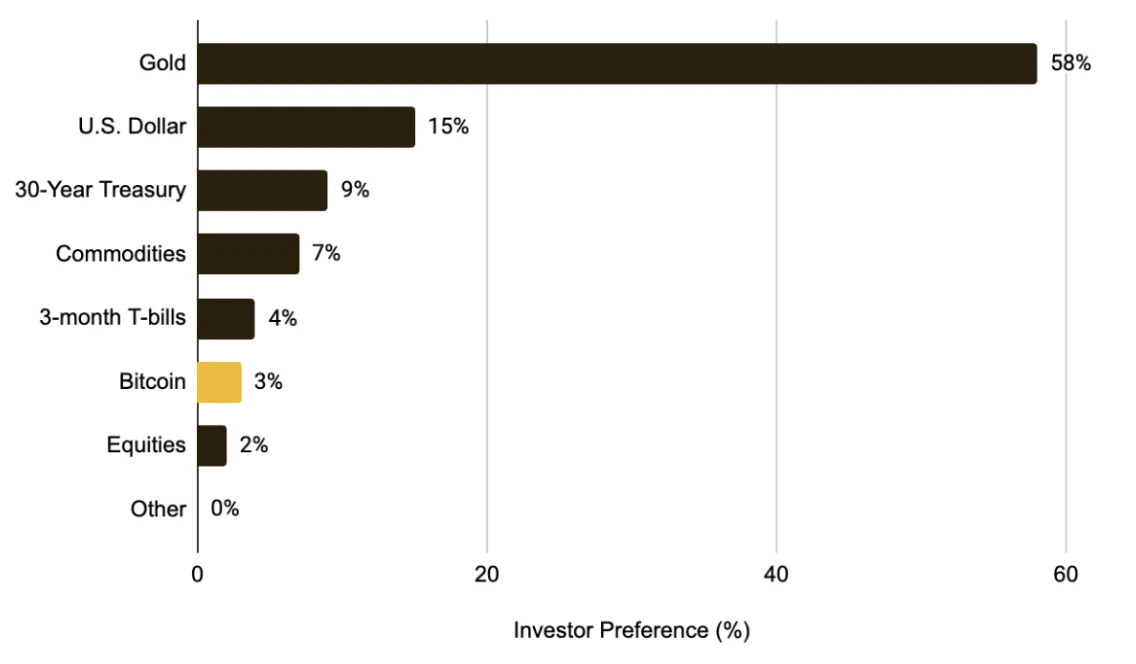
Source: BofA Global Fund Manager Survey, Binance Research, as of February 2025
2. Volatility surges
The markets sensitivity to tariff policies is evident, with each major announcement triggering wild price swings. BTC has experienced several large price swings over the past few months - including one of its largest one-day declines since the 2020 coronavirus crash. In late February 2025, when Trump suddenly announced plans to impose tariffs on Canada and the European Union, BTC fell by about 15% in the following days, while its realized volatility surged. ETH has followed a similar path, with its one-month volatility soaring from around 50% to over 100%.
These market behaviors highlight that in the current high-uncertainty macro environment, the crypto market is extremely sensitive to sudden policy changes. In the future, if the policy direction remains unclear or the trade war escalates further, the market will maintain high volatility. Historical experience also shows that volatility can only gradually decline when the market fully digests and prices the new tariff policy.
Chart 6: During this period, BTC’s January realized volatility rose to over 70% and ETH’s to over 100%, reflecting the sharp market volatility after the tariff announcement.
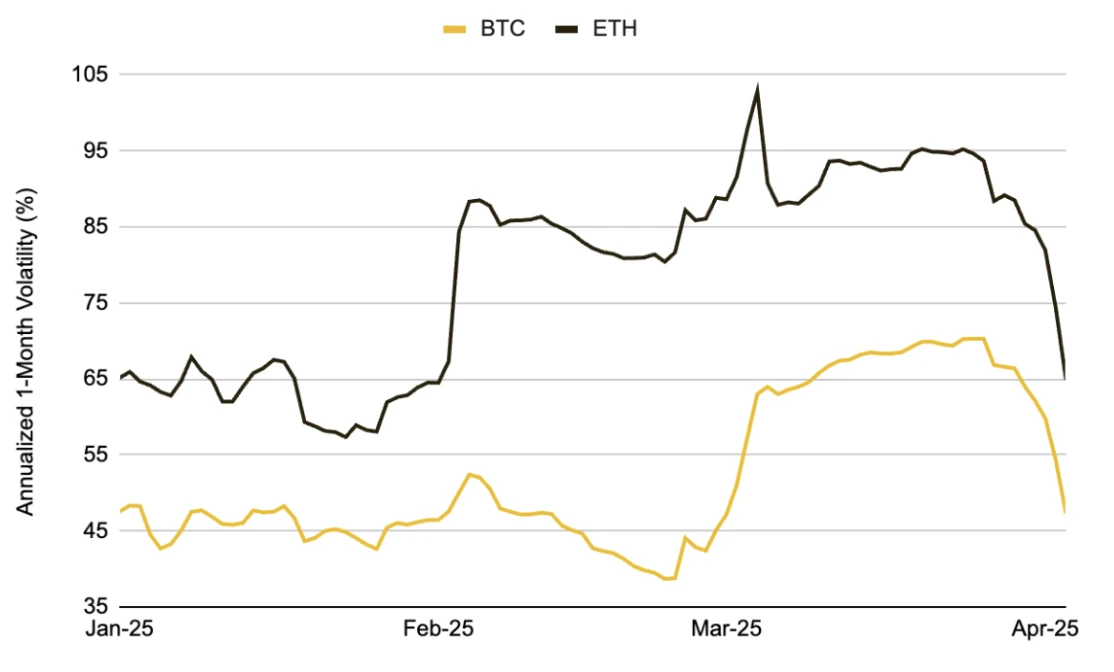
Source: Glassnode, Binance Research, as of April 4, 2025
Macroeconomic impact: inflation, stagflation concerns, interest rates and the Fed outlook
1. Inflation and stagflation concerns
The new tariffs amount to a large additional tax on imported goods, adding fuel to inflationary pressures at a time when the Fed is trying to curb price growth. Concerns have emerged in the market that these measures could derail the process of inflation retreat. Market-based indicators such as one-year inflation swaps have soared to more than 3%, while expectations in consumer surveys have risen to around 5%, both showing that people generally expect prices to continue to rise in the next 12 months.
Meanwhile, economists warn that if the trade war escalates fully and triggers a global retaliatory response, global economic output losses could be as high as $1.4 trillion. U.S. real GDP per capita is expected to fall by nearly 1% in the initial stage. Fitch Ratings pointed out that if the comprehensive tariff system persists, most economies may enter a recession, saying that the current high level of U.S. tariffs has invalidated most economic forecasting models.
Under the dual pressure of rising inflation expectations and growth concerns, the risk of the global economy sliding into stagflation (economic stagnation and rising prices coexisting) is becoming increasingly prominent.
Figure 7: Changes in macroeconomic conditions in 2025 push up 1-year expected inflation and down growth expectations

Source: University of Michigan, Binance Research, as of April 5, 2025
2. Interest rate outlook and the Fed’s stance
Federal Reserve funds rate futures data show that market expectations for rate cuts in the coming months have risen sharply. This marks a clear shift in attitude - just a few weeks ago, the Fed was still firmly committed to curbing inflation, but now, as concerns about the economic growth outlook grow, the market has begun to expect that monetary policy may turn to loose to support the economy.
Figure 8: Market expectations for rate cuts in 2025 continue to rise, with four 25bp cuts now expected – much higher than the previous expectation of just one
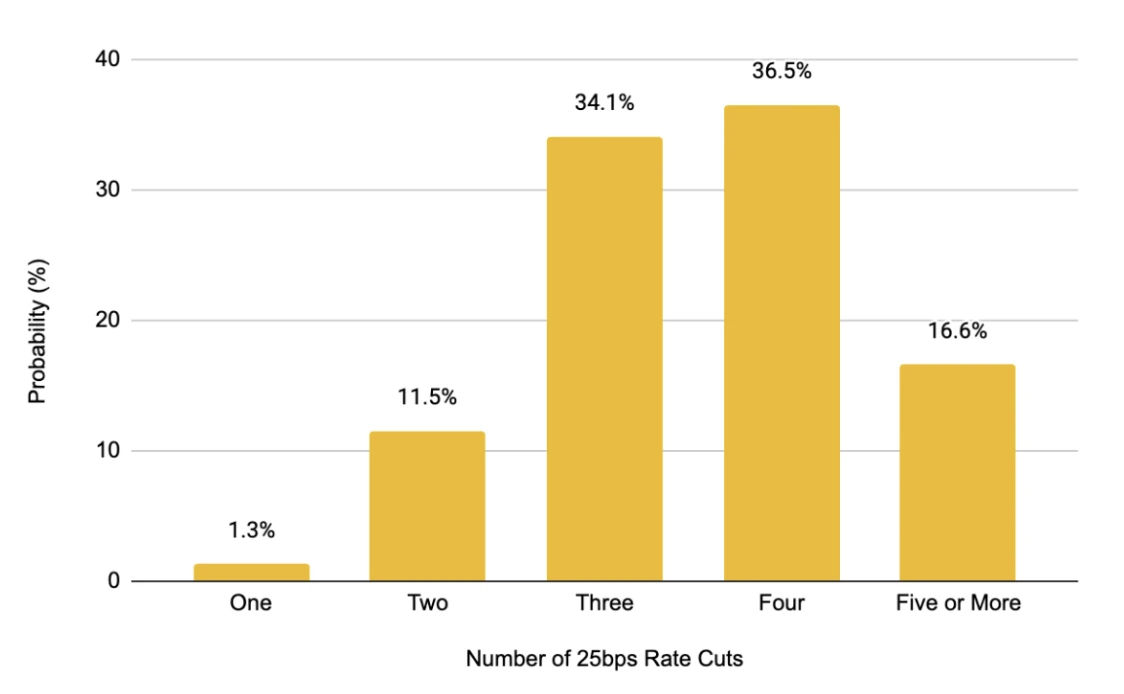
Source: CME Group, Binance Research, as of April 4, 2025
Reflecting this shift in sentiment are public statements by Federal Reserve officials, who have expressed concern and stressed that the new round of tariffs runs counter to previous economic policy. The Fed now faces a difficult choice: tolerate the additional inflation caused by tariffs, or stick to its hawkish stance and risk further depressing growth?
“The scale of tariffs announced in recent weeks has been larger than expected, and their impact on inflation and growth – especially the cumulative effects – needs to be closely monitored.”
— Jerome Powell, April 4, 2025
In the short term, the Fed appears to remain committed to keeping long-term inflation expectations stable. However, monetary policy decisions will continue to be data-dependent, depending on whether inflation or growth signals are weaker. If inflation exceeds the target by a large margin, a stagflationary environment could limit the Feds policy response. This uncertain policy outlook has also exacerbated market volatility.
Outlook
1. Relevance and Diversification
The evolving relationship between crypto assets and traditional markets is coming into focus - and Bitcoin, as the markets dominant asset, is the best window to observe this change. This round of risk-off events caused by the trade war has significantly affected the correlation structure between BTC and the stock market and traditional safe-haven assets.
Since the first mention of tariffs on January 23, the initial market reaction was mixed - Bitcoin and stocks moved slightly independently, causing their 30-day correlation to fall to -0.32 on February 20. However, as trade war rhetoric escalated and risk aversion continued to spread, this value rose to 0.47 in March, showing that Bitcoins linkage with overall risk assets has increased in the short term.
In contrast, Bitcoin’s correlation with traditional safe-haven assets such as gold has weakened significantly - the originally neutral to positive relationship turned into a negative correlation of -0.22 in early April.
These changes show that macroeconomic factors, especially trade policy and interest rate expectations, are increasingly dominating crypto market behavior, temporarily suppressing the market structure originally driven by supply and demand logic. Observing whether this correlation structure continues will help understand Bitcoins long-term positioning and its diversified value.
Figure 9: Initial reactions diverged. As the trade war escalated, BTC’s correlation with the SP 500 strengthened, while its correlation with gold continued to weaken.
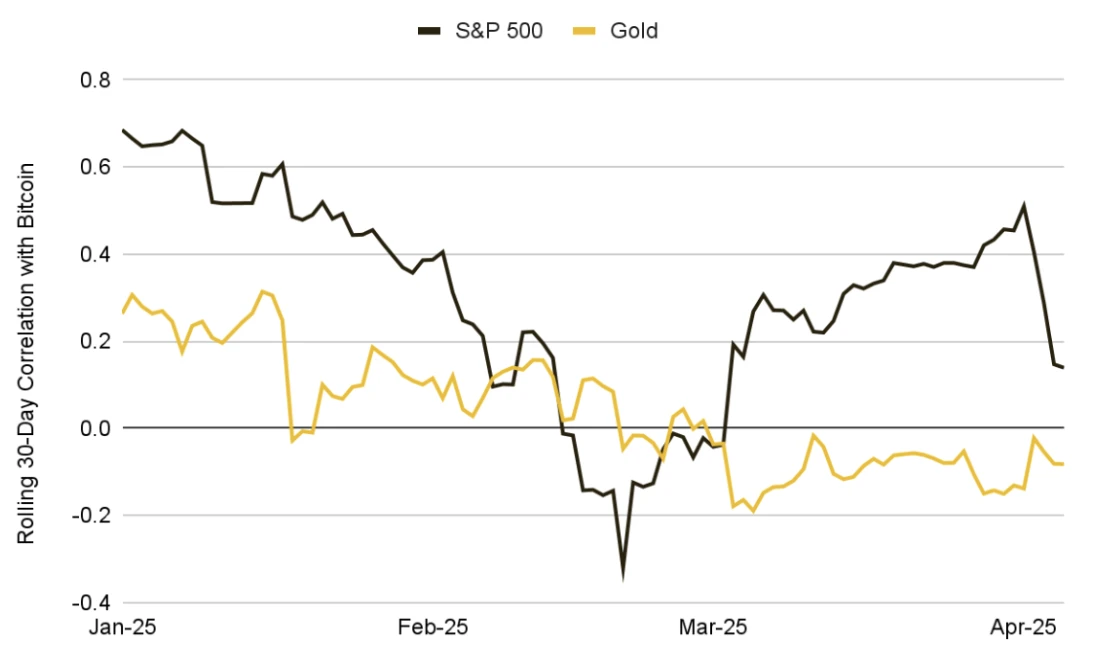
Source: Investing.com, Binance Research, as of April 5, 2025
2. Regaining the safe-haven narrative
Although recent macro and liquidity shocks have highlighted the risk attributes of crypto assets, the long-term trend remains unchanged: Bitcoins correlation with traditional markets usually rises under extreme pressure, but gradually declines after the market stabilizes. Since 2020, BTCs 90-day average correlation with the stock market is about 0.32, and with gold is only 0.12, indicating that it has always maintained a certain separation from traditional asset classes.
Even with the recent tariff announcement, BTC has shown some resilience on a weak trading day for some traditional risk assets. At the same time, the supply of long-term holders continues to rise - indicating that core holders have not significantly reduced their positions during the recent volatility, but instead have shown strong confidence.
This behavior suggests that Bitcoin may be able to re-establish a more independent macro identity despite increased short-term price volatility.
Figure 10: Bitcoin’s long-term correlation with traditional assets has remained modest since 2020: 0.32 with the SP 500 and 0.12 with gold

Source: Investing.com, Binance Research, as of April 5, 2025
The key question is whether BTC can return to its long-term structure of low correlation with the stock market. A similar trend was seen during the banking crisis in March 2023, when BTC successfully decoupled and strengthened from the stock market downturn.
Today, as tariff wars intensify and global markets begin to adjust to a long-term pattern of trade fragmentation, whether Bitcoin can once again be seen as a non-sovereign, permissionless safe-haven asset will determine its future macro role. Market participants will closely watch whether BTC can retain this independent value proposition.
One potential path is to regain its appeal during periods of monetary inflation and fiat currency depreciation, especially when the Fed turns to easing. If the Fed starts to cut interest rates and inflation remains high, Bitcoin may regain favor and be seen as a hard asset or inflation-resistant asset.
Ultimately, this process will determine BTC’s long-term positioning as an asset class — and its diversification utility in a portfolio. The same applies to other major altcoins, which present stronger risk attributes in the current environment and may continue to rely on BTC-led market sentiment.
3. Crypto Markets in a World of Stagflation and Protectionism
Looking ahead, the crypto market will face a complex macro environment dominated by trade policy risks, stagflationary pressures, and global coordination breakdown. If global growth continues to be weak and the crypto market fails to form a clear narrative, investor sentiment may decline further.
A prolonged trade war will test the resilience of the entire industry - potentially drying up retail investor flows, slowing institutional allocations, and reducing venture capital funding. Macro variables to watch closely in the coming months include:
● Trade developments: Any new tariff lists, unexpected easing measures, or major bilateral changes (such as US-China negotiations or re-escalation) will directly affect market sentiment and inflation expectations.
● Core inflation data: The upcoming CPI and PCE data are crucial. If they unexpectedly rise due to import costs, it will exacerbate stagflation concerns; if the data is weak, it may ease the pressure on the central bank and increase the attractiveness of risky assets (including crypto).
● Global growth indicators: declining consumer confidence, slowing business activity (PMI), weak labor market (rising unemployment claims, slowing non-farm payrolls), corporate profit warnings and inverted yield curves (common recession signals), etc., may further trigger risk aversion in the short term. However, if macro weakness accelerates expectations of monetary easing, it may also provide support for the crypto market.
● Central bank policy path: How the Fed and other major central banks strike a balance between inflation and recession will determine the liquidity of various asset classes. If they refuse to cut rates amid slowing growth, risk assets will continue to be under pressure; if they turn to easing, it could bring a comprehensive boost. If real interest rates fall (whether due to policy or continued inflation), long-term assets such as Bitcoin may benefit. Divergence in central bank policies (e.g. the Fed turns dovish while the ECB remains hawkish) may also stimulate cross-border capital flows, further exacerbating volatility in the crypto market.
● Crypto’s own policy events: ETF approval, strategic BTC reserves, key legislation advancement, etc., may become independent catalysts in the current macro context, and are expected to break the “macro binding” status of crypto assets and re-highlight their uniqueness. However, we should also be wary of reverse risks, such as regulatory delays or unfavorable litigation progress, which may generate negative feedback.
Conclusion
The most aggressive round of tariffs since the 1930s is having a profound impact on the macroeconomy and crypto markets. In the short term, crypto markets are likely to continue to be highly volatile, with investor sentiment swinging with trade war news.
If inflation remains high and growth slows, the Fed’s response will be a key turning point: if it turns to easing, the crypto market may rebound due to the recovery of liquidity; if it remains hawkish, pressure on risky assets will continue.
If the macro environment stabilizes, new narratives emerge, or crypto assets regain their long-term safe-haven status, the market will hopefully recover. Before then, the market may remain volatile and highly sensitive to macro news. Investors need to pay close attention to global developments, maintain diversified asset allocations, and look for opportunities in potential market dislocations caused by the trade war.









